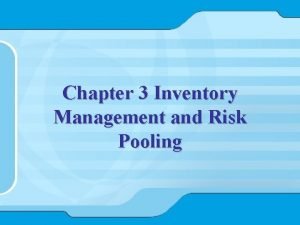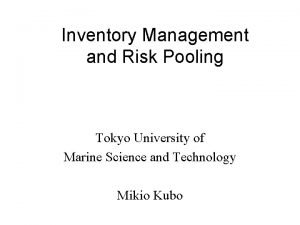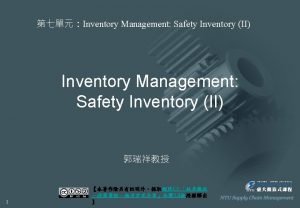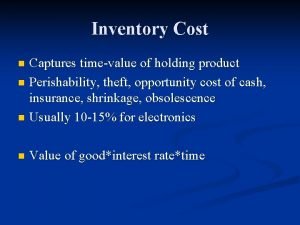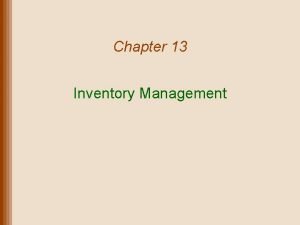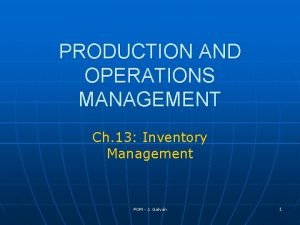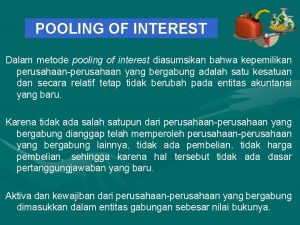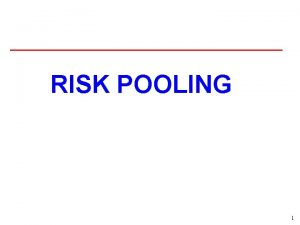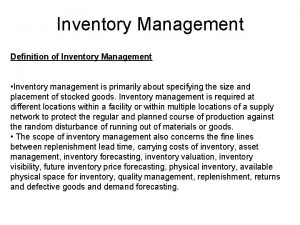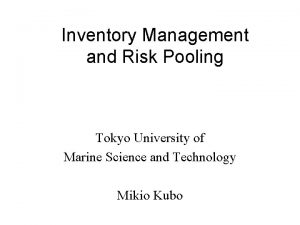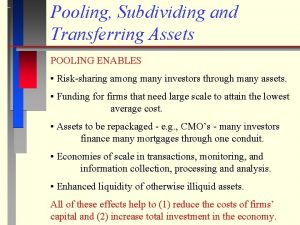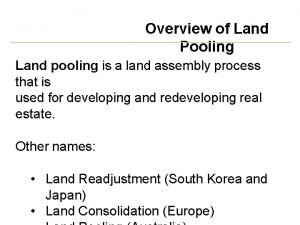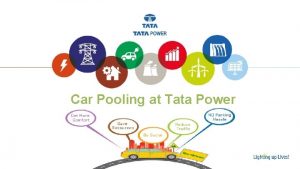Chapter 2 Inventory Management and Risk Pooling Page















- Slides: 15

Chapter 2 : Inventory Management and Risk Pooling Page 52; Section 2. 5 -2. 7. 1 Presented By: Jesse Fenton Jonathan Ross Curtis Hubbard Devin Trusty January 30, 2013 Brejia Blocker

Overview 1. Managing Inventory in the Supply Chain 2. Echelon Inventory Optimization 3. Inventory Replenishment 4. How to Calculate Reorder Point? 5. How to Calculate Economic Order Quantity (Q*) ? 6. Forecasting 7. Four General Categories 8. Judgment Methods 9. Delphi Technique 10. Top 7 Inventory Reduction Strategies

Managing Inventory in the Supply Chain • Inventory is a function of time and randomness. • Supply & demand affect on inventory • Randomness is unpredictable. • Pricing, Weather, Acts of Nature, Disease, etc. • Inventory Planning: Strategy associated with coordinating inventory with production or sales needs. • Goal: Reducing costs while increasing production levels • How much, when and where?

Echelon Inventory Optimization • Multi-facility serial supply chain: • Manufacturer Wholesaler Distributor Retailer Customer • Each stage is referred to as an echelon. • EIO Goal: Eliminate waste throughout the entire supply chain. • EIO models each echelon, cost and production, and determines need at each point in supply chain.

Inventory Replenishment Manufacturer Retailer I Wholesaler Distributor Retailer I

How to Calculate Reorder Point? • The formula for Reorder Point is • R= Le �� AVG + Z �� STD �� √�� e. • Le= Echelon Lead Time • AVG= Average Demand • STD= Standard Deviation of Demand

S D H Retailer 250 45 1. 2 Distributor 200 45 Wholesaler 205 Manufactur 500 er Q Z ST D Le (In weeks) 137 1. 88 32 1 . 9 141 1. 88 32 2 45 . 8 152 1. 88 32 3 45 . 7 255 1. 88 32 4

How to calculate Economic Order Quantity (Q*) ? •

Forecasting • The forecast is always wrong • The longer the forecast horizon, the worst the forecast • Aggregate forecasts are more accurate

Four General Categories • Judgment methods • Market Research • Time-Series Methods • Casual Methods

Judgment Methods Sales-force Composite Panel of experts • To project the future demand for a good or service • Expert judgment • Lannoy & Procaccia, 2001 • Using existing data • Predicting and decision making

Delphi Technique • Herman Kann of the RAND Corporation (1960) • survey method • encourage true debate • anonymity and feedback • action-oriented

Top 7 Inventory Reduction Strategies 1. Perform periodic inventory review. 2. Provide tight management of usage rates, lead times, and safety stock. 3. Reduce safety stock levels. 4. Introduce or enhance cycle counting practice. 5. Follow ABC approach. 6. Shift more inventory or inventory ownership to suppliers. 7. Follow quantitative approaches.

Quantitative Approaches •

Thank You Questions?
 Inventory pooling examples
Inventory pooling examples Risk pooling meaning
Risk pooling meaning Risk pooling supply chain
Risk pooling supply chain The required safety inventory
The required safety inventory Expected shortage per cycle formula
Expected shortage per cycle formula Inventory pooling
Inventory pooling Risk pooling supply chain
Risk pooling supply chain Market risk assessment
Market risk assessment Operations management chapter 12 inventory management
Operations management chapter 12 inventory management Key risk indicators for vendor management
Key risk indicators for vendor management Risk map risk management
Risk map risk management Chapter 13 inventory management problems and solutions
Chapter 13 inventory management problems and solutions Chapter 13 inventory management problems and solutions
Chapter 13 inventory management problems and solutions Apa thesis cover page
Apa thesis cover page Railcar pooling experts
Railcar pooling experts Metode pooling of interest
Metode pooling of interest
